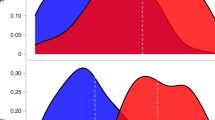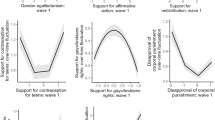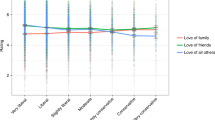Abstract
Liberals and conservatives often take opposing positions on moral issues. But what makes a moral position liberal or conservative? Why does public opinion tend to become more liberal over time? And why does public opinion change especially fast on certain issues, such as gay rights? We offer an explanation based on how different positions connect with different kinds of moral arguments. Based on a formal model of opinion dynamics, we predicted that positions better connected to harm and fairness arguments will be more popular among liberals and will become more popular over time among liberals and conservatives. Finally, the speed of this trend will be faster the better the position connects to harm and fairness arguments. These predictions all held with high accuracy in 44 years of polling on moral opinions. The model explains the connection between ideology and moral opinions, and generates precise predictions for future opinion change.
This is a preview of subscription content, access via your institution
Access options
Access Nature and 54 other Nature Portfolio journals
Get Nature+, our best-value online-access subscription
$29.99 / 30 days
cancel any time
Subscribe to this journal
Receive 12 digital issues and online access to articles
$119.00 per year
only $9.92 per issue
Buy this article
- Purchase on Springer Link
- Instant access to full article PDF
Prices may be subject to local taxes which are calculated during checkout





Similar content being viewed by others
Data availability
The MTurk data are available at https://github.com/irinavrt/moralopinion. The GSS data are available at http://gss.norc.org.
Code availability
All codes used to reproduce the results of this paper are available at https://github.com/irinavrt/moralopinion.
References
Hunter, J. D. Culture Wars: The Struggle to Control the Family, Art, Education, Law, and Politics in America (Basic Books, 1992).
Ansolabehere, S., Rodden, J. & Snyder, J. M. The strength of issues: using multiple measures to gauge preference stability, ideological constraint, and issue voting. Am. Polit. Sci. Rev. 102, 215–232 (2008).
Treier, S. & Hillygus, D. S. The nature of political ideology in the contemporary electorate. Public Opin. Q. 73, 679–703 (2009).
Inglehart, R. Culture Shift in Advanced Industrial Society (Princeton Univ. Press, 1990).
Mulligan, K., Grant, T. & Bennett, D. The dynamics of public opinion on cultural policy issues in the US, 1972–2010. Polit. Behav. 35, 807–829 (2013).
Costain, A. N. & Majstorovic, S. Congress, social movements and public opinion: multiple origins of women’s rights legislation. Polit. Res. Q. 47, 111–135 (1994).
Pollock, P. H. Issues, values, and critical moments—did ‘Magic’ Johnson transform public-opinion on AIDS? Am. J. Polit. Sci. 38, 426 (1994).
Schram, W. E. The process and Effects of Mass Communication (University of Illinois Press, 1954).
Inglehart, R. Modernization and Postmodernization: Cultural, Economic, and Political Change in 43 Societies (Princeton University Press, 1997).
Kilburn, H. W. Personal values and public opinion. Soc. Sci. Q. 90, 868–885 (2009).
Hayes, B. C. Religious identification and moral attitudes: the British case. Br. J. Sociol. 46, 457–474 (1995).
Graham, J., Haidt, J. & Nosek, B. A. Liberals and conservatives rely on different sets of moral foundations. J. Pers. Soc. Psychol. 96, 1029 (2009).
Haidt, J. & Graham, J. When morality opposes justice: conservatives have moral intuitions that liberals may not recognize. Soc. Justice Res. 20, 98–116 (2007).
Culhane, J. G. Uprooting the arguments against same-sex marriage. Cardozo Rev. 20, 1119 (1998).
Smith, T. W., Marsden, P. V., Hout, M. & Kim, J. General Social Surveys, 1972–2016 [Machine-readable data file] (National Opinion Research Center at the University of Chicago, 2017).
Koleva, S. P., Graham, J., Iyer, R., Ditto, P. H. & Haidt, J. Tracing the threads: how five moral concerns (especially Purity) help explain culture war attitudes. J. Res. Personal. 46, 184–194 (2012).
Day, M. V., Fiske, S. T., Downing, E. L. & Trail, T. E. Shifting liberal and conservative attitudes using moral foundations theory. Pers. Soc. Psychol. Bull. 40, 1559–1573 (2014).
Feinberg, M. & Willer, R. The moral roots of environmental attitudes. Psychol. Sci. 24, 56–62 (2013).
Feinberg, M. & Willer, R. From gulf to bridge: when do moral arguments facilitate political influence? Pers. Soc. Psychol. Bull. 41, 1665–1681 (2015).
Clifford, S. & Jerit, J. How words do the work of politics: moral foundations theory and the debate over stem cell research. J. Polit. 75, 659–671 (2013).
Clifford, S., Jerit, J., Rainey, C. & Motyl, M. Moral concerns and policy attitudes: investigating the influence of elite rhetoric. Polit. Commun. 32, 229–248 (2015).
Eriksson, K. & Strimling, P. Group differences in broadness of values may drive dynamics of public opinion on moral issues. Math. Soc. Sci. 77, 1–8 (2015).
Strimling, P., de Barra, M. & Eriksson, K. Asymmetries in punishment propensity may drive the civilizing process. Nat. Hum. Behav. 2, 148 (2018).
Boyd, R., Gintis, H., Bowles, S. & Richerson, P. J. The evolution of altruistic punishment. Proc. Natl Acad. Sci. 100, 3531–3535 (2003).
Azar, O. H. Evolution of social norms with heterogeneous preferences: A general model and an application to the academic review process. J. Econ. Behav. Organ. 65, 420–435 (2008).
Baldassarri, D. & Gelman, A. Partisans without constraint: political polarization and trends in American public opinion. Am. J. Sociol. 114, 408–446 (2008).
Fiorina, M. P., Abrams, S. J. & Pope, J. C. Culture war? Myth of the Polarized America (Longman Pearson, 2005).
Graham, J. et al. Moral foundations theory: The pragmatic validity of moral pluralism. in Advances in Experimental Social Psychology 47, 55–130 (Elsevier, 2013).
Shweder, R. A. Thinking Through Cultures: Expeditions in Cultural Psychology. (Harvard University Press, 1991).
Graham, J. et al. Mapping the moral domain. J. Pers. Soc. Psychol. 101, 366 (2011).
Van Leeuwen, F., Koenig, B. L., Graham, J. & Park, J. H. Moral concerns across the United States: associations with life-history variables, pathogen prevalence, urbanization, cognitive ability, and social class. Evol. Hum. Behav. 35, 464–471 (2014).
Van Leeuwen, F., Park, J. H., Koenig, B. L. & Graham, J. Regional variation in pathogen prevalence predicts endorsement of group-focused moral concerns. Evol. Hum. Behav. 33, 429–437 (2012).
Inglehart, R. & Baker, W. E. Modernization, cultural change, and the persistence of traditional values. Am. Sociol. Rev. 65, 19–51 (2000).
Inglehart, R. & Norris, P. Sacred and Secular: Religion and Politics Worldwide. Cambridge Studies in Social Theory, Religion, and Politics (Cambridge University Press Cambridge, 2011).
Andersen, R. & Fetner, T. Economic inequality and intolerance: attitudes toward homosexuality in 35 democracies. Am. J. Polit. Sci. 52, 942–958 (2008).
Iyer, R., Koleva, S., Graham, J., Ditto, P. & Haidt, J. Understanding libertarian morality: the psychological dispositions of self-identified libertarians. PloS One 7, e42366 (2012).
Buhrmester, M., Kwang, T. & Gosling, S. D. Amazon’s Mechanical Turk: a new source of inexpensive, yet high-quality, data? Perspect. Psychol. Sci. 6, 3–5 (2011).
Casler, K., Bickel, L. & Hackett, E. Separate but equal? A comparison of participants and data gathered via Amazon’s MTurk, social media, and face-to-face behavioral testing. Comput. Hum. Behav. 29, 2156–2160 (2013).
Paolacci, G., Chandler, J. & Ipeirotis, P. G. Running experiments on Amazon Mechanical Turk. Judgm. Decis. Mak. 5, 411–419 (2010).
Dance, A. News Feature: How online studies are transforming psychology research. Proc. Natl Acad. Sci. 112, 14399–14401 (2015).
Stoffel, M. A., Nakagawa, S. & Schielzeth, H. rptR: repeatability estimation and variance decomposition by generalized linear mixed-effects models. Methods Ecol. Evol. 8, 1639–1644 (2017).
Nakagawa, S. & Schielzeth, H. Repeatability for Gaussian and non-Gaussian data: a practical guide for biologists. Biol. Rev. 85, 935–956 (2010).
Nakagawa, S. & Schielzeth, H. A general and simple method for obtaining R2 from generalized linear mixed-effects models. Methods Ecol. Evol. 4, 133–142 (2013).
Acknowledgements
This research was supported by the Knut and Alice Wallenberg Foundation grants 2015.0005 and 2017.0167. The funders had no role in study design, data collection and analysis, decision to publish or preparation of the manuscript.
Author information
Authors and Affiliations
Contributions
F.J. and P.S. designed the MTurk study and collected the data, which I.V. analysed. K.E. and P.S. designed and analysed the formal model. I.V. managed and analysed the GSS data with input from K.E. and P.S. I.V. produced the figures. P.S., K.E. and I.V. wrote the paper. F.J. edited the paper.
Corresponding author
Ethics declarations
Competing interests
The authors declare no competing interests.
Additional information
Peer review information: Primary Handling Editor: Mary Elizabeth Sutherland.
Publisher’s note: Springer Nature remains neutral with regard to jurisdictional claims in published maps and institutional affiliations.
Supplementary information
Supplementary Information
Supplementary Methods 1, Supplementary Results 1 and 2, Supplementary Figs. 1–5 and Supplementary Table 1
Rights and permissions
About this article
Cite this article
Strimling, P., Vartanova, I., Jansson, F. et al. The connection between moral positions and moral arguments drives opinion change. Nat Hum Behav 3, 922–930 (2019). https://doi.org/10.1038/s41562-019-0647-x
Received:
Accepted:
Published:
Issue Date:
DOI: https://doi.org/10.1038/s41562-019-0647-x



